Evergreen flowers. Low-growing ornamental shrubs and shrubs as a garden decoration
Coming to greenhouses, a person is faced with a huge variety of these same shrubs. There are a great many of them.
- frost-resistant;
- blooming;
- undersized;
- fast growing;
- wild;
- high.
This is not the whole list of shrubs that can currently be planted on your suburban area.
blooming ornamental shrubs also differ in a special variety, ranging from blooming all summer or spring, and ending with the shape and height of the shrub. Below you can see photos and names of ornamental shrubs for summer cottages.
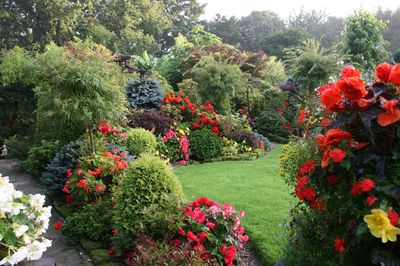
Let's look at what decorative flowering shrubs to plant in the country so that they are not dependent on climate varieties.

The Buddley shrub will bloom all summer long and create a light, unobtrusive fragrance throughout the garden. He does not care about the care and temperature of the climate in which he grows, the shrub will feel great even at +30 and +10 degrees.
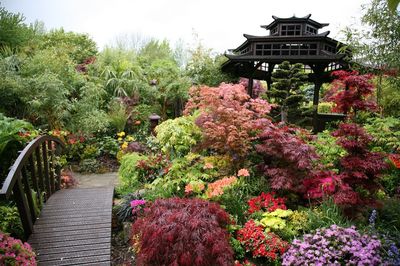
Another flowering shrub- Spirea. It blooms almost all summer, and its flowers can be of a wide variety of shapes, ranging from spherical (most familiar to gardeners) to cone-shaped. The plant eventually acquires a tree-like form.
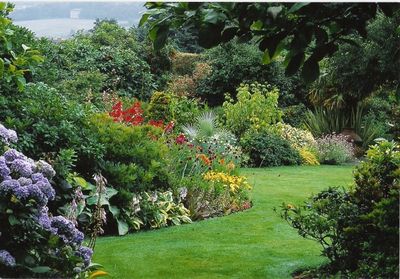
Do not forget about the familiar and beloved by many shrubs, such as lilac, wild rose or even viburnum. Currently, breeders have tried to breed lilac varieties. Which do not take up much space. And rose hips and viburnum, in addition to beauty, will also bring benefits on cold winter evenings. In addition, they are also not whimsical and do not take up much space.

What to look for when choosing frost-resistant plants?
Frost-resistant ornamental shrubs for summer cottages will appeal to those gardeners who have much more cold days than warm ones. When choosing a frost-resistant shrub, you need to pay attention to the barberry. Firstly, it is unpretentious to weather conditions, secondly, it bears fruit, and thirdly, it attracts many birds, which in turn contributes to the destruction of pests.

Almost all varieties of holly are also considered hardy. It differs from other shrubs in its insanely rich green foliage and, later, small red berries. The only thing to watch out for is that bi-color varieties can lose their color vibrancy in the shade. They would be better planted in the sun. Frost-resistant ornamental shrubs for summer cottages can be seen below in the photo.

What undersized shrubs to choose?
Small undersized shrubs do not take up much space and look very beautiful. Shrubs up to 1 meter in height are considered undersized. Shrubs can be very diverse, for example, Japanese low quince will look great as a living fence. At the beginning of flowering it is replete with bright red flowers, and later it is decorated with yellowish fruits. Frost-resistant, which is one of the pluses.
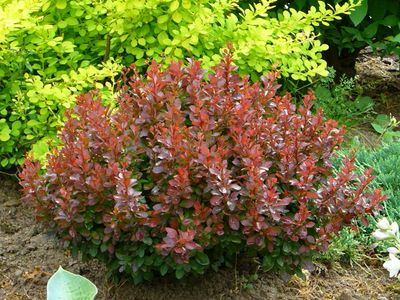
The wolf is a very beautiful plant, but not suitable for those who like to eat berries. It is unusually poisonous, so lovers of berries should avoid it. The plant should be watered at least once a week, it can die from drought. In the photo below you can see it during the flowering period.

The graceful action reaches a height of up to 80 cm. Small flowers are united by one inflorescence, the plant spreads on the ground, enveloping everything around with a wonderful aroma.
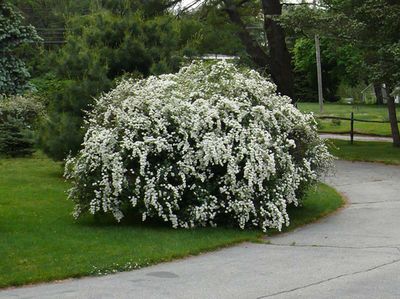
Horizontal cotoneaster is one of the most beautiful low-growing shrubs, which compensates for its slow growth with extraordinary beauty and frost resistance. Small bright green leaves later give way to small creamy pink berries.
Norway spruce will become a beautiful decoration at any summer cottage, and thanks to the efforts of breeders, it can reach only 80 cm in length. As many people know, it tolerates winter well, and against the background snowy winter evergreen bush looks great.
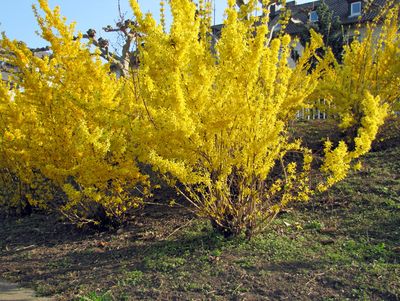
What plants are suitable for a quick hedge?
Fast-growing shrubs deserve special attention. You can plant, for example, dogwood, which will grow quickly and produce a crop by the end of summer. One of fast growing shrubs is also purple willow or goat willow. The only negative is that they require constant watering, as they do not like heat. One of the most beautiful fast growing shrubs are roses. With the right garter and haircut, you can achieve an unusually beautiful hedge.
Clematis will look great as a living bright blue hedge. Caring for them is quite difficult, so it may not be suitable for beginners. Care should be taken to ensure that the bush does not freeze, especially the part that has not yet risen to the surface. In addition, clematis bushes do not tolerate excessive moisture. You can see an example in the photo.
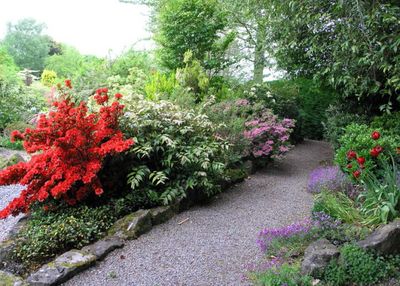
Decorative ivy will quickly and beautifully create a hedge in those places where it is needed. Too shaded places should not be used for planting it, in which case it may lose its soil. Absolutely unpretentious to watering and cutting bushes.
Whom to expect to visit if there are a lot of wild shrubs on the site?
Wild shrubs often serve as food for birds and humans. For example, the fruits of the common barberry are very fond of birds. The height of the bush can reach up to 2 meters.
Round-leaved irga is unpretentious to weather changes. It bears fruit in August, the fruits are medium-sized, but very sweet.
The turn is another bright representative of wild shrubs. Its fruits can be used in medicinal purposes, and can also be used as the main liquor for tincture or liquor. After the first frost, its fruits acquire a pleasant tart-sweet taste. The photo below shows blackthorn berries.
Aronia red or chokeberry is absolutely unpretentious, and birds eat its fruits with pleasure. Reaches a height of 1.5-2 meters.
High growing shrubs - pros and cons
The most common are high-growing coniferous shrubs. They provide an evergreen bush that, when properly planted, is able to protect against the intense summer heat. However, they need to be planted at a distance of at least 2.5 meters from the walls of a residential building. If the bush grows, it can damage the walls of the house. All types of Philadelphus, popularly called mock orange, are very common. The leaves are from small, rounded, to island-stretched, oval. Mock orange blooms with beautiful white flowers that have an odorous smell. The plant can reach a length of up to 3.5 meters.
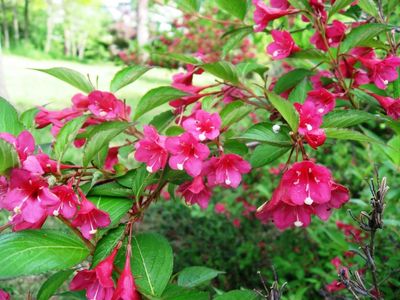
Before choosing an ornamental shrub, you need to pay attention to such factors:
- soil moisture;
- soil shading;
- the area required for the healthy growth of the shrub.
These are all factors that you should pay attention to when planting small beautiful trees in the country.
Which shrub is right for your summer cottage, and which shrubs to plant in order to get a harvest, you can find out about this in the article.
Low-growing ornamental shrubs can be conditionally divided into dwarf forms created by breeders and natural species, maternal forms that are small in size. Both of them are widely used in herbal compositions created for open ground and for growing in containers, or in winter gardens.
Low-growing ornamental shrubs are used for:
- creating borders or edging for a flower bed;
- element of flower composition (for flower beds with perennials);
- element of dendrological composition (with other shrubs and trees);
- creating compositions with stones (rock gardens, rockeries);
- growing in containers that decorate the terrace, balcony or courtyard;
- creating curtains - homogeneous groups of shrubs planted on the lawn.
Dwarf forms of bushes

Half of the popular landscape design bushes, there are dwarf and / or creeping forms. Varieties of spirea, honeysuckle, euonymus, barberry, juniper, rhododendron, cotoneaster, rose and many other plants are undersized ornamental shrubs that do not exceed 30-50 cm in height.
Usually, these forms of plants are more capricious and require more care than their larger relatives. They tolerate drought and lack of watering worse, due to a less developed root system. Such undersized varieties tend to be less hardy and more prone to disease.
All these shortcomings are compensated by the beauty, grace and sophistication of small bushes, which, due to their size, can be grown on small area soil, or in a pot, on a balcony, or in a winter garden.
Note: creeping or ampelous ornamental shrubs that are not tall, but large, belong to a different category: creeping or ampelous (falling), for example cotoneaster, juniper.
Shrubs - a small miracle created by nature
Undersized ornamental shrubs include natural forms of perennial woody plants with several branching shoots, without a main trunk. In their natural habitat, the size of shrubs does not exceed half a meter, but usually they are even lower.
The main difference from the dwarf forms of large plants is that shrubs are hardy and unpretentious. Thanks to natural immunity, not lost during selection, shrubs are frost-resistant, tolerate heat well, get sick less and require less care.
Note: when growing shrubs, allowance must be made for their ecology and natural climatic zone. For example, cranberries will need high soil moisture, as they naturally grow in swamps. And lavender, being a southern plant, will tolerate the absence of moisture well, but will be sensitive to severe frosts.

Of the shrubs, representatives of the heather family (Ericaceae) are very popular. Among them there are decorative flowering representatives - erica, heather, some rhododendrons, podbel. With bright and edible fruits - lingonberries, cranberries, blueberries, dropsy. In addition, shrubs from the heather family are evergreen. They do not shed foliage, reviving plant compositions even in late autumn, when other plants have already withered. Or in early spring, when other shrubs have not yet begun to vegetate, heather shrubs are already turning green.
Other families can also boast of the presence of small natural types of bushes. In the mint family (Lamiaceae) - thyme, rosemary, lavender. In the rose family (Rosaceae) - cloudberry, stone fruit, cinquefoil.
Attention! Only today!
A hedge is one of the most beautiful and popular design details of a suburban area. Its height depends not only on the size of the territory, but also on the functional purpose. Curb hedges are designed to frame flower beds, lawns, garden paths. The height of such a natural curb is no more than 70 centimeters. For its formation, plants are usually chosen that are unpretentious in care and adapted to the climatic conditions of the region.
curb hedge
Selection of shrubs for a living border
For those gardeners who prefer constancy, low-growing, dwarf varieties of decorative deciduous shrubs are suitable for arranging curb hedges. To create a dense sheared border about half a meter high, such undersized species as barberry, boxwood, cotoneaster, caragana, cinquefoil, honeysuckle and many other plants are chosen.
Dwarf varieties from which you can make a wonderful live border include:
Barberry boxwood. evergreen shrub retains its decorative all year round. The plant is notable for the fact that it grows on any soil, it develops well both in the shade and on the sunny side of the garden. This variety of barberry responds well to shearing, and also perfectly holds any garden shape.
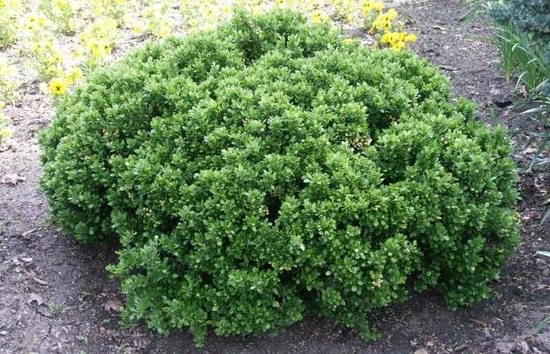 Barberry boxwood sheared
Barberry boxwood sheared Boxwood, cultivar Buxus sempervirens Suffruticosa, grows slowly. The evergreen shrub is ornamental throughout the year. Luxurious shiny dark green foliage gives a special charm to the plant. Boxwood is a great option for creating ceremonial borders. It cuts beautifully and keeps its shape for a long time. Other varieties of boxwood are also suitable for these purposes, both with green foliage and variegated ones. This plant tolerates shade and drought well. But for the winter it is better to cover it to avoid sunburn in early spring.
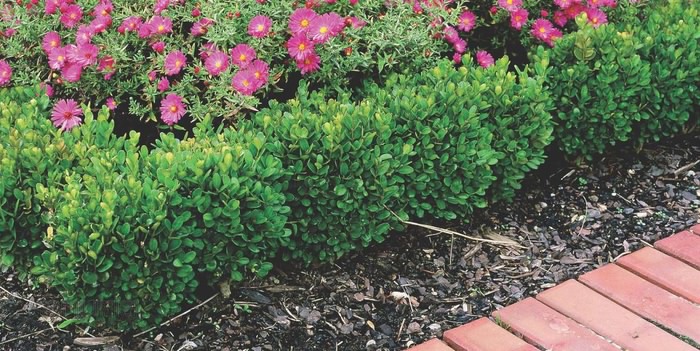 Boxwood evergreen ‘Suffruticosa’
Boxwood evergreen ‘Suffruticosa’ Fortune's euonymus. This plant is well suited for wide and low borders. Slow-growing, very low shrub almost spreads along the ground. Long shoots grow up to three meters in length, covering the soil around them. The branches are covered with numerous leathery leaves 3 to 5 centimeters long. For arranging living borders, you can use different varieties of Forchun's Euonymus, which have white-green foliage with pink veins. The plant is drought-resistant, grows well in partial shade, tolerates a haircut.
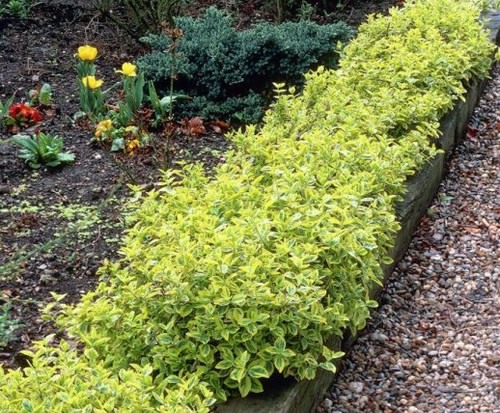
Karagana is better known to us as acacia. If you do not cut it, then you can get a prickly impenetrable hedge as a result. For arranging low borders, Karagan orange is suitable. Its shrubs grow no more than 1 meter. The crown is loose and spreading. If you regularly cut this unpretentious plant, you can get a fairly dense live border.
 Caragana shrub "Globos"
Caragana shrub "Globos" Honeysuckle brilliant - a semi-evergreen plant. Its decumbent branches densely cover shiny oblong green leaves. It is undemanding to the soil composition, it grows well both in the sun and in partial shade. This plant loves warmth. Therefore, in regions with a rather harsh climate, shiny honeysuckle sheds foliage for the winter and may freeze slightly. To protect shrubs for the period of cold weather, shelters are made.
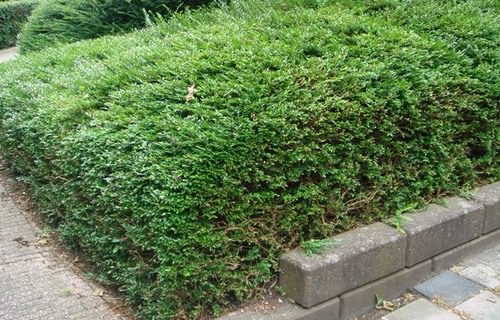 Honeysuckle brilliant
Honeysuckle brilliant Rhododendron. For borders, undersized varieties with a compact crown are chosen. Among the whole variety of colors and shapes, it is quite easy to choose shrubs with excellent decorative properties. But for any variety of rhododendrons, it is necessary to create acceptable conditions. They love the sun, or lacy penumbra, and also require protection from cold northern winds. Shrubs will thrive in acidic, well-drained soils. Evergreen varieties need shelter from the bright spring rays of the sun. Otherwise, they get severe burns.
 Rhododendron (Azalea)
Rhododendron (Azalea) Magonia holly looks great both in its natural form and in its sheared form. The border of this evergreen shrub is decorative all year round. All the beauty of this plant lies in the foliage, shiny and juicy. Serrated dark green leaves turn purple in autumn. In spring, shrubs are decorated with yellow flowers, and in winter, mahonia leaves, strewn with whole clusters of blue-black berries. This plant loves moisture, grows well in sunny areas, and requires shelter for the winter. To get a beautiful sheared border, mahonia should be cut in the spring after flowering, or in the fall.
 Mahonia holly
Mahonia holly Flowers and herbaceous plants for borders
For those who do not like monotony, the option of arranging living borders of flowers and herbs is quite suitable. Each year, the border fence can be made different, using annual flowers or fragrant herbs. Many people prefer another option: in multi-row borders, the back is made of perennial flowers and shrubs, and the front is updated annually.
Someone will laugh, and someone will take note of the idea of spicy herbs as a material for a living border. Of course, this option is not at all suitable for front porches, but in the garden such herbs are simply irreplaceable. They make pretty borders, and the excess foliage goes straight to the kitchen. Here are some ideas:
Peppermint. For the border, you can choose a variety with dark green or light foliage. The plant tends to grow rapidly, so it is recommended to plant it in separate pots, which are then dug into a trench around the perimeter of the flower bed. A neat look of such a low-growing hedge will give a timely haircut.
Oregano. The grass grows well in sunny areas and tolerates drought well. During flowering exudes a pleasant aroma.
Parsley. In order to get a thick, dense border, you need to choose curly leafy varieties.
Flower border hedges always look elegant. When choosing plants, it is imperative to take into account the flowering period in order to enjoy the chic look of natural fencing as long as possible.
Marigolds are perhaps the most popular annual plant for undersized hedges. The best option- marigolds rejected and thin-leaved. They are from 15 to 40 centimeters high. Marigolds grow quickly, are unusually beautiful during a long flowering period, and are unpretentious in care. Grow them from seeds, or buy ready-made seedlings. They should be planted at a distance of 10 - 20 centimeters from each other.

Kochia is another annual plant that is called summer cypress. The spherical shape of the bush is strewn with thin long leaves. The plant prefers dry, acidic soils.
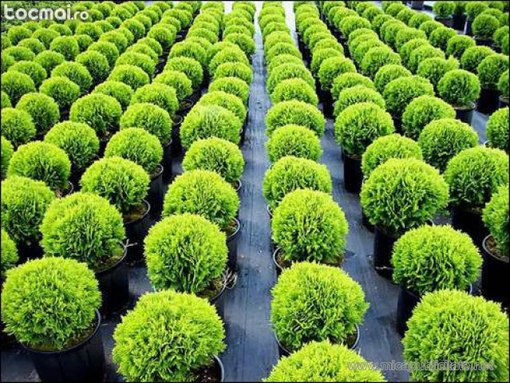 Kochia
Kochia Gomphrena is an annual grown from seedlings. In care, the plant is unpretentious, and it must be planted after spring frosts.
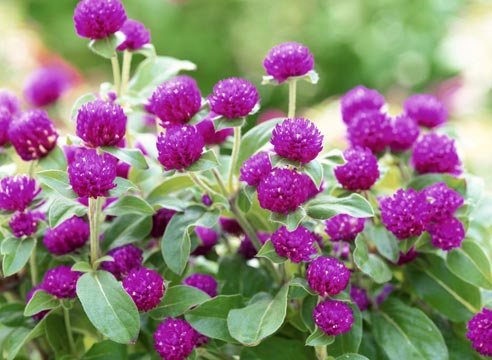 Gomphrena
Gomphrena Lungwort - perennial, which will delight for a very long time with its magnificent appearance. A lungwort border will always be luxurious in shaded areas of the garden.
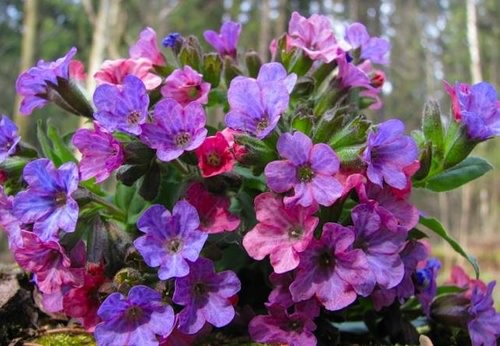 Lungwort
Lungwort Rules for arranging curb fences
To get a dense and dense living border, plants need to be planted in two or three rows. It will look neat if you keep its width no more than 30 centimeters.
Before planting, the place for the future border must be cleared of weeds, loosened, and, if necessary, fertilized. Plants can be planted with seedlings, or you can sow a marked area.
If you know exactly what the composition of the soil is on your site, then in accordance with this you can easily make a choice. suitable plants. For example:
- On loam, you can form a living border from the Gnome mock orange or the Dwarf mock orange.
- If the soil is sandy and moist, then Japanese quince, beautiful quince, common heather, lingonberries will grow well on it.
- Sandy dry soils are preferred: alpine willow, steppe almond, steppe cherry, Bessey cherry, sand cherry, caragana.
- Wet neutral soil is an occasion to plant a live border of ferruginous cherries, mock oranges "Dwarf" or "Gnome", holly magonia.
- Undemanding to the soil composition: purple broom, birch meadowsweet, Bover's meadowsweet, Thunberg's barberry, Daurian Kuril tea, mountain pine.
Don't be afraid to experiment in your area. Living borders will complement the beautiful picture of your garden, add their own zest to it, and surprise with splendor. The fruits of your labor will surely be appreciated by relatives and friends.
There have been, are and will be disputes around the digging of the near-stem circle of fruit trees for a very long time, probably as long as gardens exist. There are quite a few options for keeping the near-stem circle of a fruit tree, here there is black steam (namely, digging), and turfing, and mulching, and each of these activities has both pluses and minuses. Digging the soil in the near-stem strip and mulching can be combined, including here also watering and fertilizing.
Long gone are the days when daylilies in every city courtyard and garden looked the same. Today, a variety of delightful beautiful day is able to compete even with tulips. And new varieties appear almost every day. Extravagant or touching modern daylilies have made a leap forward and firmly entrenched in the lists of favorite perennials. And even the most frilly and rare varieties still live up to its reputation as an unpretentious culture.
Planting garlic before winter is a responsible event, here you need to choose the right planting material, correctly determine the planting time, know the subtleties and rules, nuances and features. Let me start with such nuances. Garlic has two different forms: one is referred to as non-arrowing, the second is arrowing. What is an arrow? The simplest is the peduncle. The arrow is formed only by winter garlic, that is, the one that we sow in autumn.
Lecho from zucchini for the winter with peppers, tomatoes and onions is another way to preserve the harvest of vegetables and replenish supplies with delicious vegetable stew. The stew turns out to be similar in taste to the traditional lecho, pieces of bell pepper replace tender zucchini. When you open the jar, the smell spreads incredibly seductive. I advise you to use containers with a capacity of 500 to 800 g for preparing salads - it is convenient to sterilize and open canned food does not have to be stored.
Everyone needs a transplant sooner or later. indoor plants. But in the case of indoor large-sized, it is not carried out as long as possible, since this is not an easy task. And rarely, what adult plants need an annual transplant. In years when transplantation is not carried out, it is recommended to perform a mandatory procedure - a partial replacement of the soil. The topsoil is replaced both for hygiene purposes and to maintain the normal state of the substrate.
Winter pickled cucumbers, crunchy, jarred with garlic, onion and chili are another easy way to prepare savory vegetables for winter. There are many recipes for pickles and marinades, even a lot. This recipe has a twist that is intended for spicy lovers: add a pinch of cayenne pepper to the marinade, and a green chili pod to the vegetables. Such cucumbers, ladies forgive me, will appeal to the strong half of humanity - an amazing cold appetizer.
The vast majority of gardeners, especially summer residents, after the end of the berry picking season, forget about their shrubs until next spring and, at best, feed them after the snow melts with a handful of nitroammophos or weed them, removing the rapidly growing couch grass. This fate befell the black currant. Although outwardly the culture seems to be a healthy and strong shrub, it also requires care and attention. And especially in the autumn, when there is a long winter ahead.
Hydrangeas - shrubs are not only fashionable, but also irreplaceable. They are used both in urban landscaping and in private gardens, paying tribute to the bright foliage, pastel colors of the inflorescence caps and stable decorative effect. Most often, hydrangeas are planted in groups or singly, mixing with other bushes and trees. Meanwhile, perennials will also be able to keep these garden princesses company, with the help of which you can create colorful, stylish and expressive combinations.
Lentil cutlets with chanterelles is a delicious, original hot dish that can be served for dinner with a side dish of mashed potatoes and a thick white sauce. If you want to surprise your guests and family, cook these tender meatballs. You can replace chanterelles with champignons, because it is not every month that you will meet in the forest or on the market exactly “forest gold”. I cooked cutlets from Canadian green lentils, they are cooked in about half an hour. Regular lentils need to be soaked in advance.
In the current season, alas, there is no record apple harvest: the rainy and rather cool summer, which looked like a mixture of autumn and spring, interfered. But still, there is a harvest, it is tangible, and if we do not want the harvested apples to spoil in a couple of weeks, they must be properly stored. They say that with proper storage, an apple can lie for several years, retaining its varietal qualities and properties, but why should we wait so long to taste it?!
One of the most original types of indoor blehnum ferns is rightfully considered one of the most capricious. Its thermophilicity and humidity requirements have turned this relic plant into a real legend. Blekhnum, or derbyanka in the room - the fern is not for everyone, but it is surprisingly beautiful. Rather large sizes and remotely reminiscent of palm leaves, fronds will easily outshine any other decorative leafy plant in your interior.
Pancakes from zucchini with cheese and garlic - tasty dish worthy of a Sunday breakfast, especially in harvest season. Pancakes are a useful thing, you can’t prepare them for the future, but you can completely eliminate part of the crop with benefit. For a family of three, one medium-sized vegetable weighing up to 1 kilogram minus cleaning is used. From this amount, you get an impressive appetizing slide of pancakes, which will famously leave with sour cream while watching the Sunday morning show.
Mixed ridges and narrow long flower beds along the paths and walls are in fashion today. And although this is the most colorful, it is not the only design option for colorful plant frames of various functional purposes. Sometimes it is not advisable to break even the smallest ridge about half a meter wide; the design requires greater rigor and “subtlety” of the plant line. A narrow and neat border of one plant is the most obvious, but the only way out.
Now is the very beginning of autumn, the whole crop has not even been harvested from the site yet. But you may not believe that in order to ensure the harvest of the next season, the vacated soil, for future beds, is already time to start preparing. And this is not a joke at all: you need to prepare this soil correctly so as not to be disappointed in the next year's harvest. How to prepare the beds, how to properly dig and fertilize the most common vegetable crops right now, we will tell you today.
Pickled cucumbers in circles with citric acid are garnish cucumbers, the cooking principle of which I somehow spied on in one TV show. They showed a large factory where cucumbers are pickled for hamburgers. These are really excellent side dishes, which are indispensable in cases of emergency, when there is no time to cook dinner, but you need to feed your family. On a plate to mashed potatoes and sausages put a slide of cucumbers with onions - and it's already delicious!



